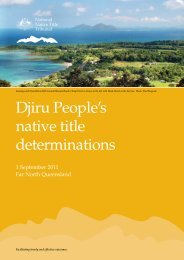Biodiveristy_State of Environment report - Mission Beach Cassowaries
Biodiveristy_State of Environment report - Mission Beach Cassowaries
Biodiveristy_State of Environment report - Mission Beach Cassowaries
- No tags were found...
You also want an ePaper? Increase the reach of your titles
YUMPU automatically turns print PDFs into web optimized ePapers that Google loves.
and Hales 1997) where freshwater Melaleucastands have died, and mangroves are establishingin amongst the dead trees.The ecological function <strong>of</strong> saltwater wetlandscompared to freshwater wetlands can also beexpected to vary. Saltwater wetlands withmangroves may have different capacities fornutrient recycling than swathes <strong>of</strong> grass andsedges in freshwater wetlands.Current LegislationMost remaining wetlands in the Shire are underprotection as remnant vegetation areas. The WaterAct (2000) also deems some areas a 'lake' if theyhave a defined bed and bank, with continual waterlevels. Work permits are required from NR&Mfor any alteration to the bed or bank. A fewsporadic patches exist that are outside this protection, near<strong>Mission</strong> <strong>Beach</strong> and Mourilyan. These are bulkuru wetlandsites that do not have well defined bed or banks, and areperiodically inundated during the wet season, but are also dryfor part <strong>of</strong> the year. It is possible for local government tonominate a region for declaration as a 'Drainage andEmbankment Area' under the Water Act (2000) to furtherprotect wetlands, but aside from the few bulkuru locations onprivate land, this would have little value in the Shire; mostareas are either gone already or are under other protection.Whilst large areas <strong>of</strong> the remaining wetlands are withinprotected areas and cannot be cleared, they are stillvulnerable to further changes to drainage. In theory, diversion<strong>of</strong> water in a catchment may affect the wetland hydrology.There is no regulation preventing alteration <strong>of</strong> drainagediverting water away from a watercourse. NR&M onlyregulate drainage causing an impact to the stream bank orvegetation at the location where it empties into the naturalstream. QPWS operate on a systems <strong>of</strong> 'good neighbour'agreements with landholders surrounding the wetland areas.Water allocation issues will also continue to affect therepresentation <strong>of</strong> freshwater wetlands. Water allocation isfurther discussed in the Water and Atmosphere chapter (linkto water allocation). It is important that ecological function <strong>of</strong>wetland areas be incorporated into water allocation planning.Rec: Water allocation requires determination with regard towetland ecosystems in the catchment. A water resourceplan be completed by NR&M by 2008 - NR&MRec: Council and other groups promote preservation andrestoration <strong>of</strong> wetland ecosystems - Council, Landcare,NR&M, DPI&F, Innisfail City Wetlands SteeringCommittee, JSRIT, JRCMAResponseBulkuru (Elaeocharis dulcis) swampCouncil's focus should be to encourage and prioritise therestoration <strong>of</strong> wetland areas where possible in the Shire.These areas will return great ecological values to thecatchments. Benefits will be the provision <strong>of</strong> additionalhabitat <strong>of</strong> this restricted type, <strong>of</strong> wetland ecologicalfunction in reducing pollution to waterways, and also inacting as flood retention areas.Work by the Innisfail City Wetlands Steering Committeemay result in the restoration <strong>of</strong> natural drainage to restore awetland area adjacent to the town. Whilst this is acomparatively small area, the project will help to promotefurther work towards protecting and re-establishingwetland ecosystems elsewhere in the Shire.To be promoted to landholders, along with development <strong>of</strong>capacity by Council's revegetation unit, is restoring 'miniwetland'areas on properties in the Shire. These areenvisioned as small-scale lagoons, built at an affordablecost, that provide an ecological role in removing nutrientsand sediments from run<strong>of</strong>f. The area is also beneficial ashabitat for wildlife and can provide amenity for recreationand fishing. Where small isolated wetlands do exist onprivate land in the Shire there is scope for improvementworks, and possible linkage connections.The Innisfail City Wetlands will be <strong>of</strong> great benefit inproviding a pilot model for this type <strong>of</strong> work.QPWSQPWS is active in acquiring private land adjacent tonational park or where linkages between natural areas canbe created. A particular focus is given to wetland areas inthe Shire, due to the number <strong>of</strong> endangered wetlandTable 2.1.3d - Changes to Catchment Wetland Areas - Tidal and Non-tidal VegetationSource: adapted from Zeller (1998) and Russell and Hales (1997)Johnstone Moresby Year Liverpool MariaNon-tidal(ha)Tidal(ha)Non-tidal(ha)Tidal(ha)Non-tidal(ha)Tidal(ha)1951/2 2677 176 3363 22331992 925 202 1175 2873Net change -1752 +26 -2188 +640% Change -65.4% +14.8% -65% +29%Non-tidal(ha)1997 259 132 1687 422Tidal(ha)41



